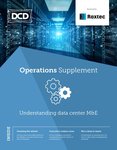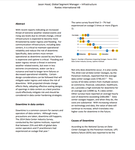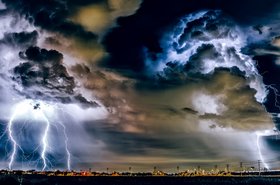According to Hood, Roxtec was built on a central idea: safety. The founder of Roxtec developed the original product concepts in his garage in Sweden, after seeing problems with other cable and pipe seals in the market. Hood recalls that at that time, existing products were more prone to failure for a variety of reasons. Roxtec continues to operate on the key basis of safety, and aims to offer high value solutions that optimize safety and the protection of people and assets.
Hood has worked at Roxtec for over a decade, bringing with him significant experience in business development across a variety of industry portfolios. He is currently focused on data centers, life sciences, semiconductor and advanced facilities as part of the infrastructure segment.
We wanted to gain a better understanding of Roxtec’s current role in the data center industry, and how Hood envisions Roxtec tackling edge deployment, climate change and more.
Starting something new
We asked Hood to provide us with a retrospective of Roxtec’s beginnings, and how its mission and core values have evolved with the business. At its core - Roxtec is focused on protecting life and assets. Initially beginning in shipbuilding, the team at Roxtec quickly learned how important it was to protect critical infrastructure, and of course people. The standards in this industry were quite high, as you could imagine - especially for Navy contracts. This allowed Roxtec to transition into new markets such as data centers, as Roxtec’s core mission aligns closely with the goals and aims of the industry.
From Hood’s perspective, manufacturing is a competitive landscape, specifically so in the data center industry. However, he highlights that many of Roxtec’s competitors tend to focus on singular threats such as water or dust. He says Roxtec wanted to offer protection against multiple threats that would have the longevity and applicability to a range of data center infrastructure models.
Hood also makes an interesting point about their mission as it pertains to edge infrastructure; often these facilities won’t be manned so the need to protect people is less critical than the need to protect infrastructure. However, this presents its own opportunities and challenges for an organization like Roxtec. Remote infrastructure still needs to be protected from fire, water, dust, etc. but how you deal with that and protect it will differ depending on how the facility is manned.
A global outlook
Hood says being a global company presents some challenges, however, these challenges are outweighed by the exceptional number of opportunities. Playing to these opportunities is one of Roxtec’s key strengths. Hood says Roxtec has subsidiaries and local support experts across the globe that are able to assist their customers in various regions with ease. Additionally, they focus on localized value chains that are able to support regional customers.
Hood reiterated that Roxtec’s mission as a global company is harmonized across all geographies - the focus on safety and protection of assets is paramount. Roxtec has a number of projects that help customers mitigate risk, create safer environments and protect critical infrastructure.
Many projects Hood has worked on came about due to customers underestimating their need for protective infrastructure. He recalls numerous conversations in which customers express how they regret not exploring protecting their infrastructure previously. However, Hood believes Roxtec has a part to play in educating the market about the evolving requirements in the industry, and the impact regionality has on the operation and maintenance of data centers.
How to tackle climate change
We asked Hood what role he believes Roxtec has in tackling climate change, one of the most serious challenges facing the world. Hood says part of Roxtec’s strategy is to implement products that futureproof data centers in high risk areas, specifically around water protection - mainly for areas at risk of rising sea levels and high rainfall.
Beyond this, Roxtec has also implemented strategies to reduce its own carbon footprint. Roxtec established a Sustainability Forum that will collect and analyze data within their own supply chains to identify where carbon emissions can be reduced or eliminated. This forum has already highlighted three key areas that are opportunities for improvement. This includes: reducing energy consumption at the manufacturing level, minimizing air-freight shipments and purchasing renewable energy technologies.
Hood says this Sustainability Forum will monitor these areas according to the Greenhouse Gas Protocol, but also continually identify and make improvements to help reduce Roxtec’s impact on the environment.
Overall, Hood has seen a general shift in awareness and responsibility for taking action not only to tackle climate change, but also to protect critical infrastructure. He says that he has seen a transition from indifference to a more ardent approach to things such as cable and pipe penetrations. The changes in the market over time have highlighted to Hood and the team at Roxtec their need to educate the market, and provide it with future-proofed, flexible products to protect critical infrastructure.
-

The Operations Supplement
Understanding data center M&E - from concrete, to water, to grease
-

Water mitigation in data centers
With increased extreme weather related events and rising sea levels due to climate change, critical infrastructure is becoming more threatened by water ingress and flooding. This paper outlines how data center operators can mitigate for threat
-

Preparing for natural disasters
Global warming will raise water levels round the world. Data centers need to prepare for floods
